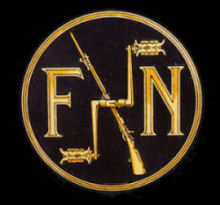

Fabrique Nationale, Avenue Malakoff, Paris, show the standard F.N. motor-bicycle with all the recently introduced features. The new F.N. four-seated car is an object of great interest. It is a splendidly finished vehicle, the dark green finish and burnished brass work showing off to advantage.
Paris Salon 1902 in Motor Cycling, December 17th, 1902.
W. R. McTaggart, Ltd.
Here will be found the latest patterns of F.N. motor cycles. The engine will be 2¾ h.p., and the construction of the machine has been studied so as to obtain the highest possible efficiency. The driving belt will be V-shape Lincona, and will be 3/8in. longer in the drive than this season's 2 h.p. F.N. The lubricating arrangement will consist of a feed lubricator fitted between the diagonal tube and the back stay. The whole front of the new machine is strengthened by a liner running through the fork stem, branching at the crown right down through the fork blades. The petrol tank itself has been very much improved, being made of oxidised brass. All jointing is avoided as much as possible, one side only being soldered. Two brakes are fitted, acting on the rim of the rear wheel, one of which is worked by back-pedalling, the other being the usual Bowden brake. All the leading features of the 2 h.p. F.N. will be retained, especially as regards the position of the engine in the frame. There is a special arrangement, by which the exhaust valve is in a manner separated from the cylinder, thus precluding the possibility of overheating. The tyres on the new machine will be 2¼ in. Clincher A Won. The tubing used in the construction of the F.N. machine will be nickel steel, which is sixty-four per cent, stronger than the ordinary cold-drawn steel tubing. All the joints, lugs, etc., including the fork crown, will be made from solid steel forgings, which are one hundred per cent, stronger in some strains, and from twenty-five to fifty per cent, stronger in others above malleable iron castings. The crank case bearing will be of the well-known turbine grooved type, which obtains the best results by perfect distribution of the lubricating oil.
The Motor Cycle, November 18th 1903, p796
Stanley Show 1903